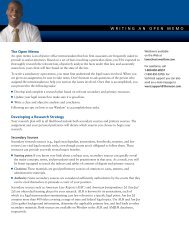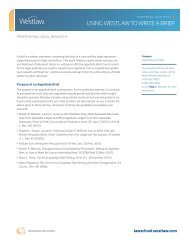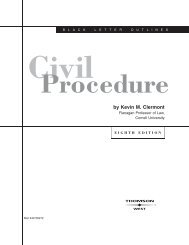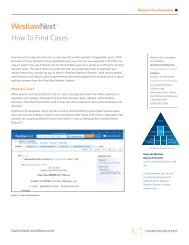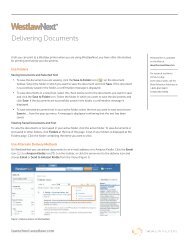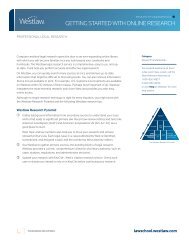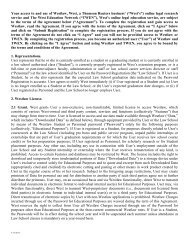Winning Research Skills - Westlaw
Winning Research Skills - Westlaw
Winning Research Skills - Westlaw
Create successful ePaper yourself
Turn your PDF publications into a flip-book with our unique Google optimized e-Paper software.
Chapter 2<br />
If you have many cases to read, you can quickly scan the synopses to weed out the irrelevant<br />
cases, but be advised that the synopsis is not part of the opinion. It is a helpful editorial<br />
enhancement prepared by the publisher. Sometimes the court itself provides a synopsis. In that<br />
case, you may see two synopses when you look at the document in a West reporter or on<br />
<strong>Westlaw</strong>—one synopsis from West and one from the court.<br />
Judge<br />
The name of the judge who wrote the opinion is listed both in the synopsis or syllabus of a case<br />
and on a separate line preceding the opinion. When more than one judge hears a case, the names<br />
of judges who subscribe to an opinion (whether it is the opinion of the court, a concurring<br />
opinion, or a dissenting opinion) are also provided. On <strong>Westlaw</strong>, the <strong>Westlaw</strong> Profiler feature<br />
provides you with a direct link between a case law document you are viewing and a biographical<br />
profile (where available) of the judge in the case.<br />
Headnotes, Topics, and Key Numbers<br />
Court decisions typically contain at least one legal issue. An issue is the question raised when the<br />
facts of the case intersect with the rules of law. West attorney-editors identify the legal issues in<br />
cases and discuss each issue in a headnote. Each headnote is usually one sentence. In reporters<br />
and on <strong>Westlaw</strong>, headnotes appear between the synopsis and the opinion. A headnote in a<br />
reporter begins with a number in boldface type followed by a topic name and key number. A<br />
headnote on <strong>Westlaw</strong> contains additional information showing the full classification hierarchy<br />
from the West Key Number System.<br />
Headnotes are numbered so you can use them as you would a table of contents to the case.<br />
Numbers corresponding to the headnote numbers appear inside brackets within the text of the<br />
opinion. The bracketed number indicates the portion of text summarized by a particular<br />
headnote. On <strong>Westlaw</strong>, you can jump from a headnote to the corresponding portion of the<br />
opinion by clicking a hypertext link.<br />
Immediately following the headnote number is the broad legal topic under which a West<br />
attorney-editor has classified that particular headnote. Topics are the main headnote<br />
classification. You can look in a West digest volume for the topic that you need or search cases<br />
on <strong>Westlaw</strong> by topic.<br />
After the topic in a West reporter, a key number is given. On <strong>Westlaw</strong>, the full classification<br />
hierarchy appears between the topic and the key number. The key number represents a specific<br />
aspect or subsection of a topic. For example, under topic 226, Joint Tenancy, key number 6<br />
covers survivorship. West attorney-editors classify a headnote under all the applicable topics and<br />
key numbers. The complete topic and key number outline is available on <strong>Westlaw</strong> in the West<br />
Key Number Digest, which is discussed in Chapter 10.<br />
Headnotes from cases are grouped in books called digests, where they are arranged by topics<br />
and key numbers. Once you find a relevant topic and key number, you can continue with the<br />
digests or search for the topic and key number on <strong>Westlaw</strong> (as explained in Chapter 10). The<br />
lines of text in the digest are actually the headnotes themselves.<br />
Writing headnotes is an art, not a science. Two attorney-editors may each see different sets of<br />
legal issues in the same case. As in the debate as to whether Gene Kelly or Fred Astaire was the<br />
20 <strong>Winning</strong> <strong>Research</strong> <strong>Skills</strong>



